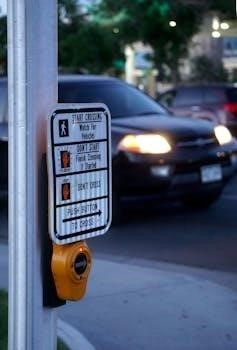This manual is designed to aid prospective NEMT owners in maintaining compliance with regulations. It covers crucial aspects of non-emergency medical transportation. Some states require these policies and procedures for licensing, ensuring a robust and safe service. The manual includes guidelines for service delivery, driver requirements, and compliance with federal directives.
Defining Non-Emergency Medical Transportation (NEMT)
Non-Emergency Medical Transportation, or NEMT, is a vital service designed to provide transportation for individuals who need assistance getting to and from medical appointments, but do not require the immediate attention of emergency services. NEMT ensures that individuals with mobility challenges, disabilities, or other limitations can access necessary healthcare services without facing transportation barriers. This type of transportation is specifically for situations that do not present an immediate risk to life or health. It includes transportation to routine doctor’s visits, therapy sessions, and other healthcare-related appointments that are not considered urgent. NEMT is a crucial component of healthcare access, particularly for Medicaid beneficiaries and others who may not have alternative means of transportation. The primary focus of NEMT is on facilitating access to healthcare for non-emergency medical needs, ensuring that individuals can attend their appointments and receive the care they require without transportation issues hindering their healthcare journey. NEMT services may include various forms of transportation depending on the individual’s needs, such as wheelchair-accessible vehicles, taxis, or other suitable transportation options.

NEMT Eligibility and Authorization
This section outlines the criteria for NEMT service eligibility, focusing on medical necessity and Medicaid coverage. It also details the prior authorization process, ensuring appropriate use of resources for eligible beneficiaries seeking non-emergency medical transport.
Medicaid Coverage for NEMT Services
Medicaid plays a significant role in providing access to non-emergency medical transportation (NEMT) for eligible beneficiaries. This coverage is designed to ensure that individuals who lack other means of transportation can attend essential medical appointments and receive necessary healthcare services. The primary focus of Medicaid-funded NEMT is on trips where the main purpose is to access medical care. This includes doctor visits, therapy sessions, and other healthcare-related appointments. Medicaid coverage is not intended for trips that are primarily for non-medical purposes, such as social events or recreational activities.
Coverage is typically limited to situations where the beneficiary is enrolled in a Medicaid program that includes NEMT benefits. It is important to verify the specific coverage details within a beneficiary’s plan, as eligibility and the scope of services can vary depending on the state and plan. Medicaid-funded NEMT is a crucial aspect of ensuring equitable access to healthcare for vulnerable populations, helping to bridge the transportation gap that can often prevent people from receiving the medical care they need. The services must be medically necessary and cost effective, and there should be no other means of transportation available to the beneficiary.
Prior Authorization Process for NEMT
The prior authorization process for Non-Emergency Medical Transportation (NEMT) is a critical step to ensure appropriate and cost-effective use of services. This process typically requires that a request for NEMT services be submitted and approved before the transportation is provided. The goal of prior authorization is to verify the medical necessity of the trip and the eligibility of the beneficiary for the service. This often involves submitting detailed information about the medical appointment, the beneficiary’s condition, and their lack of alternative transportation options. The prior authorization may be reviewed by a case manager, or other designated personnel.
The process for obtaining prior authorization can vary depending on the state, the specific Medicaid plan, and the type of transportation service requested. Some plans may require prior authorization only for certain types of NEMT such as trips exceeding a specific distance or for specialized services, like ambulette or ambulance transport. Providers must maintain records of these authorizations. Proper authorization is crucial for NEMT providers to ensure they receive reimbursement for the services. It also prevents unnecessary service utilization and ensures that resources are allocated effectively to those who need it most. Failure to obtain authorization may lead to denied claims and financial burdens for providers.

Operational Procedures for NEMT
This section outlines the essential operational procedures for NEMT providers. It covers service delivery systems, driver qualifications, and vehicle maintenance. These procedures ensure safe, reliable, and compliant transportation for all eligible individuals, adhering to regulatory standards.
NEMT Service Delivery Systems
Non-Emergency Medical Transportation (NEMT) service delivery encompasses various models designed to meet diverse needs. These systems range from direct provider models, where an organization directly operates a fleet, to brokerage systems, where third-party entities manage transportation requests. Another prevalent model involves managed care organizations integrating NEMT into their health plans. Each system presents unique operational considerations, impacting scheduling, dispatch, and overall service efficiency. Understanding these different systems is crucial for NEMT providers to ensure optimal service delivery. Additionally, the choice of delivery system often depends on state-specific regulations and available resources. Some regions may utilize a combination of these systems. Furthermore, volunteer drivers and family member reimbursements may supplement formal NEMT programs. Effective management of these diverse systems is key to providing accessible and reliable transportation. Moreover, some systems will be more appropriate depending on the client’s needs. Ultimately, a system should ensure timely and suitable access to medical appointments. Finally, the choice of model should be driven by the specific needs of a given service area, while complying with all rules.
Driver and Vehicle Requirements
Ensuring safe and reliable Non-Emergency Medical Transportation (NEMT) necessitates stringent driver and vehicle requirements. Drivers must possess valid licenses and undergo thorough background checks. This includes verification of driving records and criminal history screenings. Regular training programs are essential, covering topics such as passenger assistance, first aid, and sensitivity training. Moreover, drivers must be knowledgeable about HIPAA regulations to protect patient privacy. Vehicle requirements are equally crucial, mandating regular maintenance and safety inspections. Vehicles must be properly equipped to accommodate passengers with varying mobility needs, including wheelchair accessibility. Insurance coverage must meet state and federal requirements, providing liability protection. Furthermore, vehicles should be clean and well-maintained, ensuring a comfortable and safe environment. Some regions will require specific types of vehicles to accommodate clients. Compliance with all applicable regulations is mandatory for all drivers and vehicles. Regular vehicle inspections and driver evaluations are also required. These requirements are vital for maintaining a safe and secure transport service; Finally, the NEMT provider must keep accurate records of all drivers and vehicles.

Compliance and Quality Assurance
NEMT providers must adhere to federal and state directives. Self-auditing procedures are essential for maintaining service quality. Regular compliance checks help ensure adherence to all regulations. These measures maintain high standards of care.
NEMT Compliance with Federal and State Directives
Non-Emergency Medical Transportation (NEMT) services must strictly adhere to a complex web of federal and state regulations. These directives are put in place to ensure the safety, quality, and accessibility of transportation for individuals who require assistance in reaching their medical appointments. Compliance is not merely a suggestion; it is a legal requirement that impacts every aspect of NEMT operations. Providers must be fully aware of and up-to-date with the specific mandates from their state’s Department of Health and Human Services, as well as any relevant federal guidelines. These regulations often cover areas such as driver qualifications, vehicle safety standards, record-keeping practices, and patient confidentiality protocols. Furthermore, NEMT providers are expected to demonstrate a clear understanding of their obligations under Medicaid and other healthcare programs. Failure to comply with these directives can result in penalties, including fines, suspension of services, and even legal action. Therefore, a commitment to rigorous compliance is vital for the continued operation and success of any NEMT service. It is important to stay informed of changes and updates in regulations.
Self-Auditing Procedures for NEMT Providers
Self-auditing is a critical component of effective Non-Emergency Medical Transportation (NEMT) operations, allowing providers to proactively identify and rectify any deviations from established policies, procedures, and regulatory requirements. Regular self-audits help NEMT providers ensure they are consistently meeting the high standards expected of them. These audits should encompass all aspects of the operation, from vehicle maintenance and driver training to dispatch procedures and record-keeping. A comprehensive self-audit program includes the development of checklists and protocols that allow for systematic review of operational processes. This involves periodically examining trip logs, driver credentials, vehicle inspection reports, and all other relevant documentation. By identifying areas of non-compliance, NEMT providers can implement corrective actions and minimize the risk of penalties or service disruptions. Moreover, self-auditing should be an ongoing process, not just a one-time event, with regular reviews to ensure continued adherence to standards. This proactive approach demonstrates a commitment to quality and accountability, ultimately enhancing patient safety and improving the overall effectiveness of the NEMT service. The findings of these audits should be documented and used to improve operations.

Emergency vs. Non-Emergency Transportation
Distinguishing between emergency and non-emergency medical transport is crucial. Emergencies involve immediate threats to life, requiring swift action. Non-emergency transport is for scheduled medical appointments, not life-threatening situations. This distinction affects service type.
Distinguishing Between Emergency and Non-Emergency Medical Transport
Understanding the difference between emergency and non-emergency medical transportation is paramount in the healthcare system. Emergency medical transport addresses situations where an individual faces an immediate and severe health risk, requiring urgent medical attention and immediate transport to a medical facility. These situations often involve life-threatening conditions that demand rapid response from emergency medical services, utilizing ambulances equipped with advanced life support. Conversely, non-emergency medical transportation (NEMT) caters to individuals who require transportation to scheduled medical appointments, treatments, or other healthcare-related services, but do not face an immediate health crisis. NEMT services are designed for situations where the individual is medically stable but lacks the means to reach their destination, often using vehicles like vans or sedans. The primary differentiator is the urgency of the medical need; emergency situations require immediate response, while NEMT caters to pre-scheduled care.
